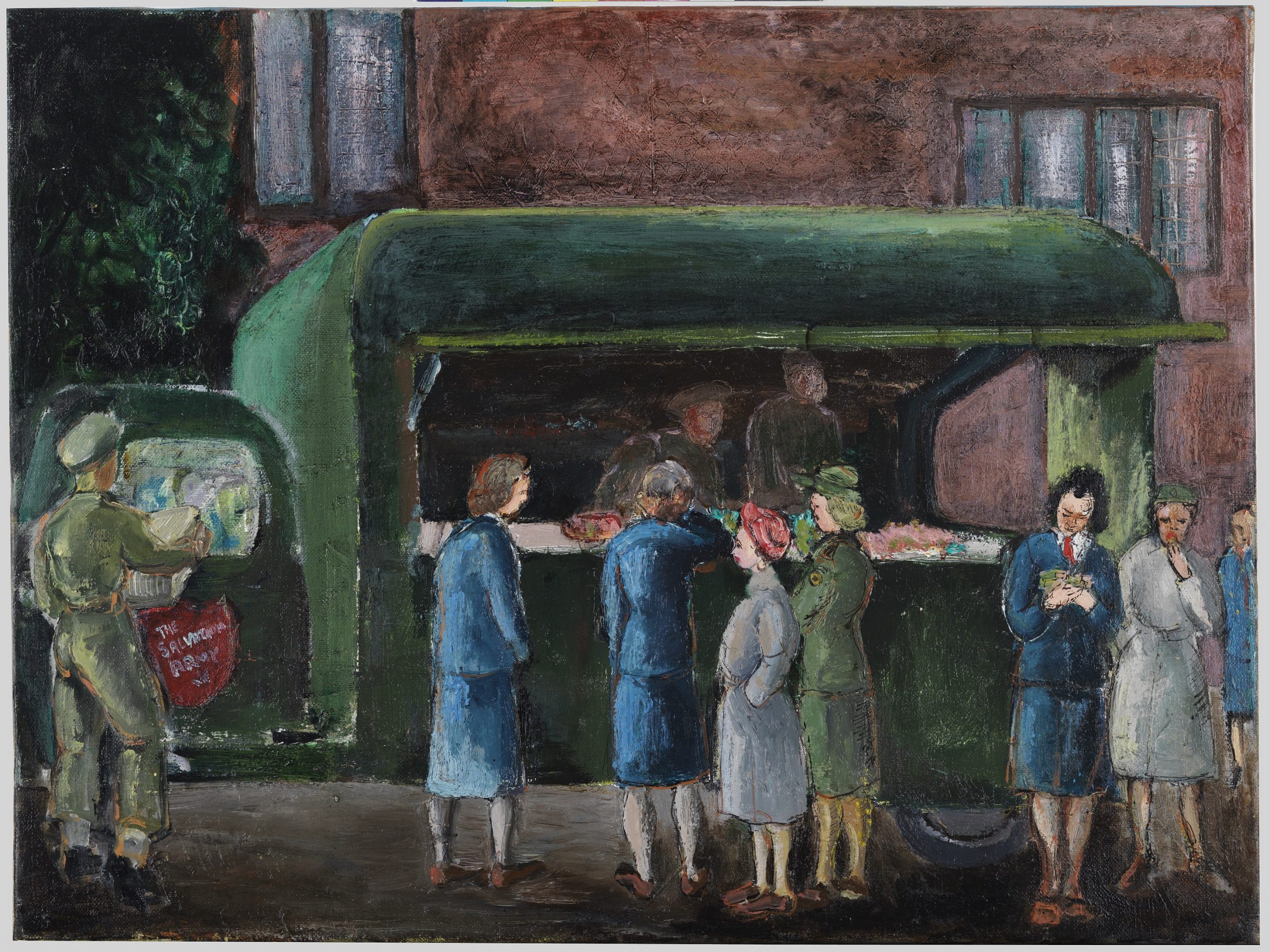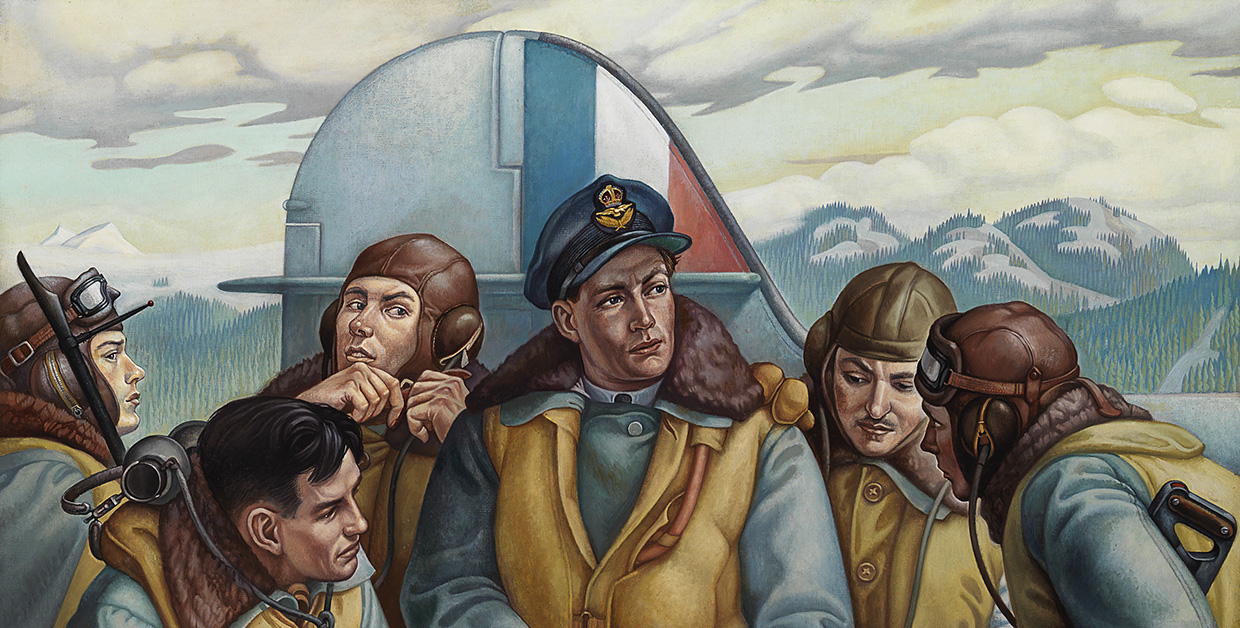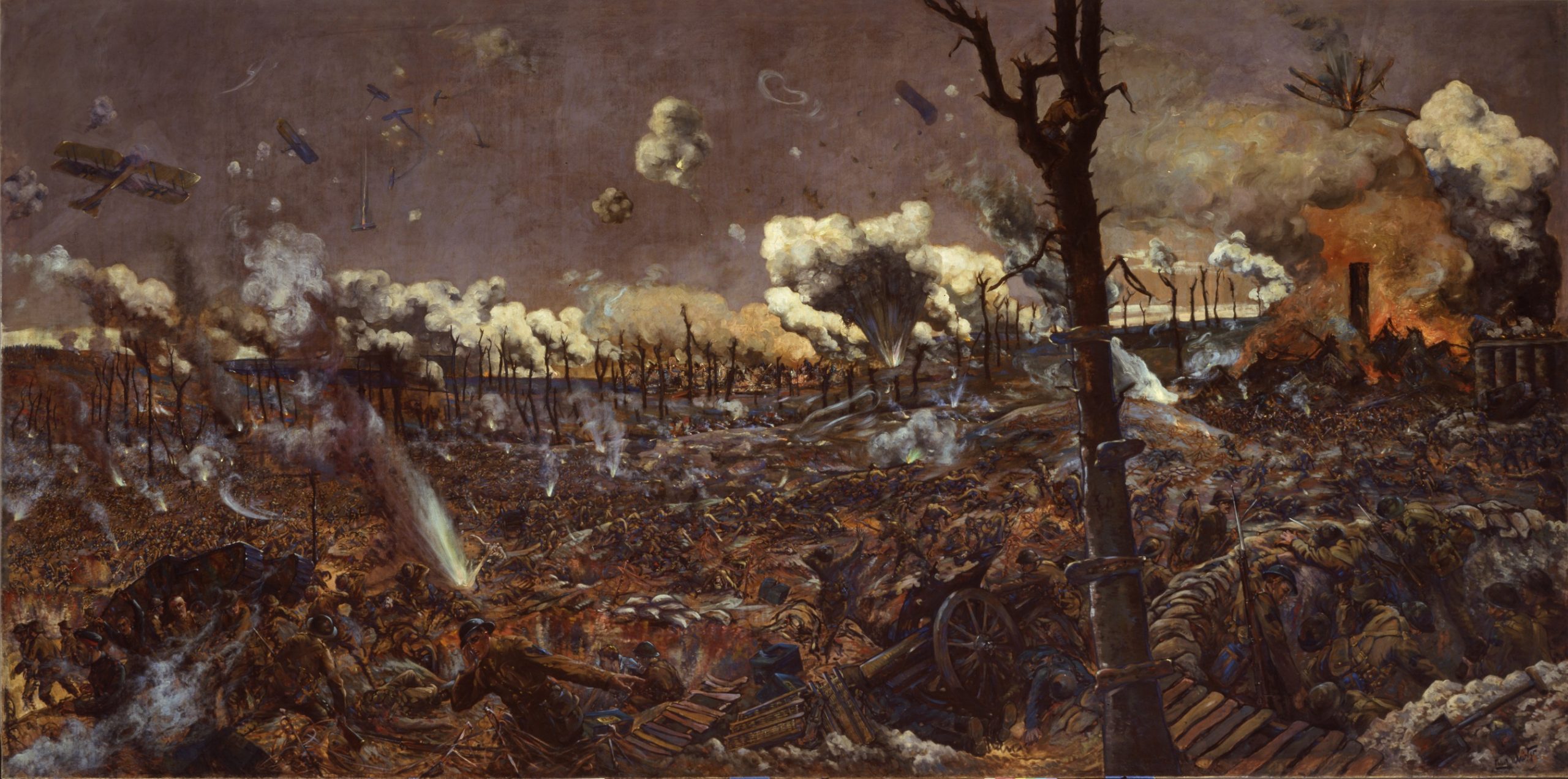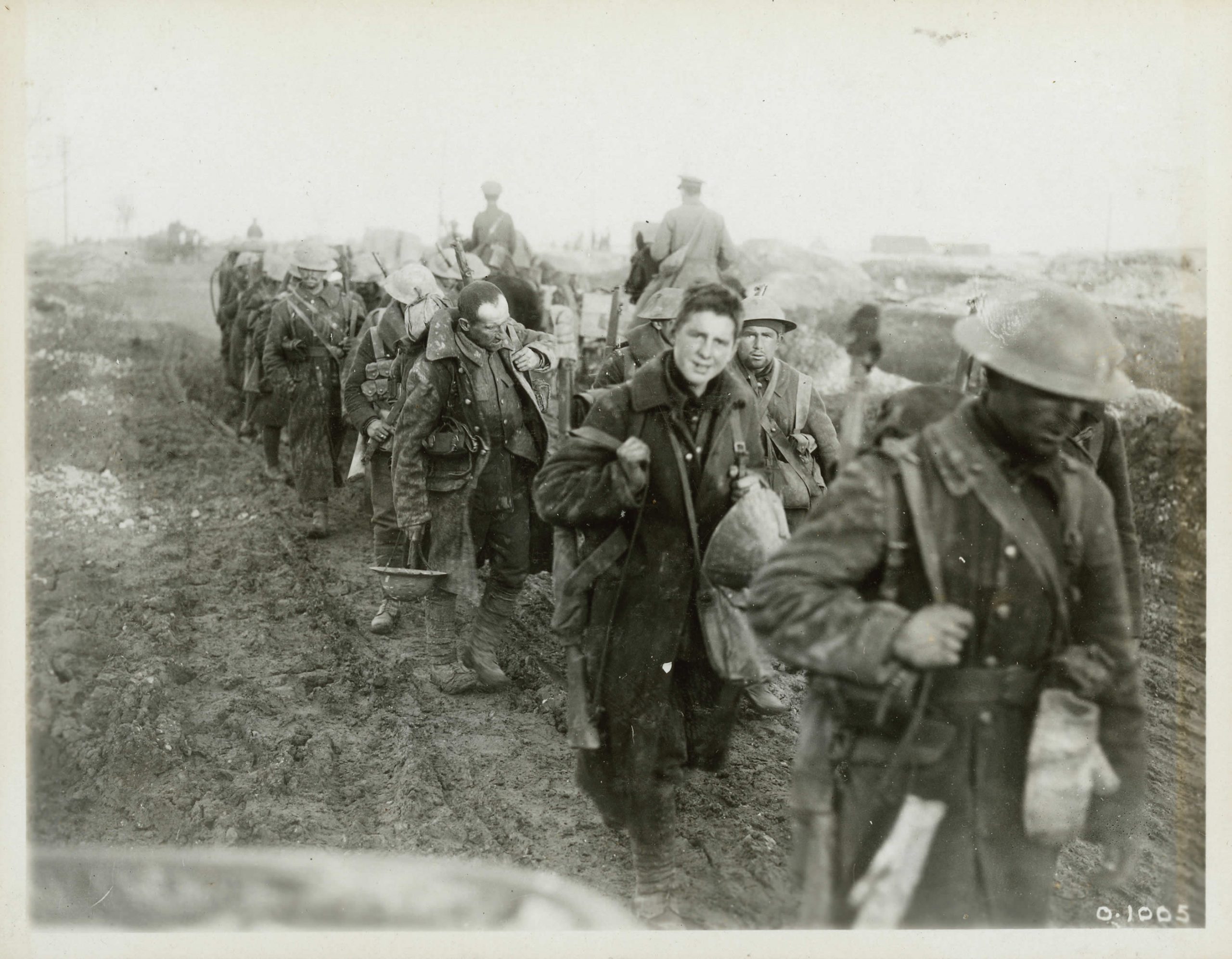From the series “Dispatches: Backgrounders in Canadian Military History”
(Note that some of the content in this series is outdated and is under review.)
The Salvation Army, an evangelical, socially-minded Christian religion organized in London, England in 1865 has existed in Canada since 1882. Despite its martial-sounding name, military organization, and rank structure – all reflecting its ‘war’ on social evils and faithlessness – the Salvation Army does not advocate taking up arms against fellow human beings. Nevertheless, Salvationists recognize that the scourge of war can, under certain conditions, be preferable to the greater evil of continued persecution and oppression. Following the outbreak of war in 1914 and again in 1939, the Salvation Army’s humanitarian concerns formed the basis of its support for Canada’s war efforts.
The Salvation Army War Services
War and training for war are draining physical, psycho-logical, and emotional experiences. During both world wars and throughout the Cold War, the Salvation Army provided Canadian military personnel overseas and in Canada with comforts such as hot drinks and snacks and helped maintain morale by establishing leave centres for rest and recreation. The Salvation Army tried to establish a degree of civility amidst the loneliness and dehumanizing conditions of war – to offer a ‘touch of home’, perhaps. To a remarkable degree, the Salvation Army formed an integral part of Canadians’ military experiences for most of this century.
The Salvation Army maintained morale on the home front with a strong presence at Canadian military installations and in major urban areas and by assisting the families of those in uniform. Closer to the battle front, the Salvation Army showed films, organized sporting events, and provided reading material, cigarettes and other items which the troops greatly appreciated. The Salvation Army also offered spiritual guidance and personal counselling to all military personnel seeking it.
The First World War
During the First World War (1914-18), the Canadian Salvation Army’s overseas activities were part of the much larger effort organized by British Salvationists. The latter established over 200 recreational huts (often no more than tents), 40 rest homes, and 96 hostels, all staffed by more than 1200 volunteers. The Canadian Salvation Army sent five military chaplains to the front and helped operate well-equipped huts, canteens, rest facilities, and hostels in Britain, France and Belgium. There, war-weary troops could bathe, refresh their clothing, eat decent food, and prepare themselves physically, mentally, and spiritually for the always difficult return to the trenches. Closer to the front, more Salvation Army officers provided refreshments and amenities, often under dangerous conditions. As Canadian soldier Will Bird wrote in his classic war memoir, Ghosts Have Warm Hands: “Every front-line soldier of World War I knew that his true friend was the man in the Salvation Army canteen.” The troops coined the affectionate nickname ‘Sally Ann’ to describe the Salvation Army while the familiar Red Shield logo – the emblem of its war efforts – also dates from this period.
In Canada, the Salvation Army Home League raised funds and sent tens of thousands of comfort packages containing socks, underwear, Christmas presents, and other items directly to the Salvation Army chaplains for distribution to Canadian troops. Salvationists also visited the homes of departed soldiers to look into the welfare of their dependants and comforted many bereaved families.
The Salvation Army’s most visible wartime effort was assisting repatriated soldiers. In 1918, it organized its first nation-wide appeal for funds to assist returning soldiers in the hectic and often disorienting days following their discharge. Within a year, the organization raised enough money to open a number of hostels across Canada – in Toronto, Montreal, Winnipeg, Halifax, Kingston, and elsewhere – each offering a quiet retreat, especially for soldiers on their way home or awaiting demobilization at war’s end. The more than $1.5 million collected astounded Salvation Army officials, whose good works during the war had not gone unnoticed by the Canadian public.
The Second World War
War with Germany broke out again in September 1939. In November, Ottawa accorded the Salvation Army official status as a Canadian War Auxiliary Service, a distinction also awarded the Canadian Legion, the Young Men’s Christian Association, and the Knights of Columbus. The Salvation Army’s war efforts were again known collectively as the Red Shield services. A government Memorandum of Understanding stipulated that all these organizations’ wartime services would be non-profit and that none could act autonomously to dispense war-related assistance. The Salvation Army understood that Ottawa’s co-ordination of all Auxiliary War Services would eliminate duplication of effort in matters affecting military welfare. In 1942, each group agreed to specialize in certain fields, with the Salvation Army assuming responsibility for canteens and the showing of films. Each organization initially raised its own funds to finance their auxiliary work. However, by April the federal government concluded that such private fund-raising siphoned off amounts it hoped to raise from the sale of Victory Bonds. Accordingly, Ottawa decided to finance these groups’ activities directly, which henceforth the Department of National War Services administered.
Nevertheless, it remained for Salvation Army supervisors to dispense Red Shield services to the troops. The Salvation Army selected these men for their resourcefulness, initiative, moral conduct, and good physical condition. Overseas, supervisors’ jobs varied according to the theatre of operations and the individual service to which they were attached. Their responsibilities included screening films, establishing canteens, organizing recreational activities such as concerts or sporting events, providing reading material and stationery, comforting the wounded, or even helping bury the dead. In short, they did whatever was necessary to help maintain military morale. The Salvation Army instructed its supervisors to “care for the body, mind and soul of every [service person] irrespective of. creed or personality.” As Salvation Army historian Scott Young has written, the Salvation Army “provided the reassuring link between the fighting man and his world of peace and kindness and sanity.”
Red Shield supervisors retained their status as civilians but held military rank equivalent to an army captain. In 1940, Ottawa issued each the uniform (minus rank insignia) of their respective service and units with the addition of Red Shield and Auxiliary War Services badges. The supervisors, who possessed no military command authority, were managed overseas by a senior supervisor reporting to a force director who, in turn, answered to the Salvation Army’s war services secretary in Canada. The latter obtained his directions from the Auxiliary Services division of the Department of National War Services.
Alf Steele, the first Red Shield Director, went overseas in December 1939 and established Salvation Army head-quarters in London. Within a month, five additional supervisors had joined him in assisting the growing number of Canadian troops sent to Britain. The Salvation Army opened its first overseas hut at Aldershot, where the Canadians underwent training, and in May 1940 established leave accommodation for the men in London at the former West Central Hotel. There, soldiers could obtain a bed, breakfast, and bath for less than 50 cents a night. More huts, clubs, hostels, and leave centres soon followed.
During Canadian training exercises in Britain, the Salvation Army’s mobile canteens supplied tired men with coffee, donuts, chocolates, and cigarettes. By early 1944, 70 Red Shield supervisors operated 30 centres and 55 mobile canteens in support of Canadian army and air force units. Moreover, the Salvation Army film service’s 375 projectors in Britain showed two complete programs weekly. The Salvation Army rest camp for the Royal Canadian Navy in Northern Ireland had one unforeseen but welcome consequence: a local magistrate noted that following the establishment of the facility, the number of Canadian sailors appearing before Londonderry courts dropped 50 per cent!
In July 1943, Canadian troops participated in the Allied invasion of Sicily. Salvation Army supervisors accompanied them. Fifteen were assigned to help alleviate the Canadians’ stressful experience of sustained combat, including three who landed almost immediately after the initial assault. When, in early September, the Allies invaded the Italian mainland, Red Shield supervisors again quickly followed, establishing a Red Shield Club, a hostel, and canteens at Campobasso. As more Canadian forces arrived in Italy, eight additional Salvation Army supervisors came with them. In the town of Riccione, on the Adriatic coast, the Grand Hotel became a rest facility accommodating 500 men with the luxury of comfortable mattresses, meals served on china dishes, and a working elevator.
In June 1944, the Allies began the liberation of Northwest Europe by invading Normandy, France. Within days of the initial assault, the first of 40 Red Shield supervisors to serve in Northwest Europe were ashore; they showed their first film to the exhausted men just five days after the invasion. Salvation Army supervisors spread heavy tarps over the holed roofs and shattered walls of damaged buildings, proclaimed the sites ‘movie theatres’, and welcomed hundreds of fatigued Canadians in need of a laugh or distraction. Eventually, the Salvation Army set up recreational facilities in large urban centres, such as Nijmegen and Brussels, after their liberation by Allied forces.
The Red Shield men followed the unit (normally battalion-sized) to which they were attached, identifying with it and getting to know the men. By this stage of the war, each supervisor was equipped with a large truck carrying a portable generator, movie projector, turntable, radio, sports equipment, games, and canteen supplies. Two military personnel were assigned to each supervisor as assistants.
Until 1944, the Red Shield effort was greater in Canada than overseas. The work closely resembled that undertaken during the First World War: setting up facilities at or near Canadian military installations, sending packages of comforts overseas (a task undertaken by the Salvation Army Women’s Auxiliary), and looking in on the families of Canadians away on active service. By 1945, the Salvation Army had established a coast-to-coast network of 165 centres, huts, hostels, and canteens.
In all, Red Shield services in Canada and overseas cost $21 million and provided Canadians with more than 270 million sheets of writing paper and envelopes, 38 million hot beverages from mobile canteens, and 35 million meals served in huts and hostels. More than 68 million people attended Salvation Army films and concerts. Over 200 Salvation Army supervisors served overseas, the last one not returning home until December 1946. In an official letter of thanks following the end of the war in Europe, General Harry Crerar, former commander of First Canadian Army, wrote: “It would be easier to forget one’s name than fail to remember the times without number when the Salvation Army was, in truth, our comforter and friend.”
The Cold War and Beyond
In 1949, the Canadian military decided that it would be “wholly responsible for the control, supervision and distribution of welfare facilities abroad, afloat and within fixed service installations in Canada.” Accordingly, the military organized its own small auxiliary and welfare units for service during the Korean War (1950-1953). These arrangements proved insufficient, however, and compared poorly with those offered by the Auxiliary Services of the Second World War.
With the onset of the ‘Cold War’, the Salvation Army continued its role as a familiar friend to Canada’s military forces. This was not without initial opposition from some Canadian military officials who believed that if the Salvation Army was allowed to set up an official auxiliary service, other organizations would demand similar privileges at a time when there was no perceived need for their services. In 1952, the first two Salvation Army officials, Captain and Mrs. A. Hopkinson, arrived in Germany to open a ‘Canadian’ hostel and snack bar for the thousands of Canadians stationed alongside British forces near Hanover with North Atlantic Treaty Organization (NATO) forces. This snack bar, serving North American-style food, and stocked with Canadian newspapers, was at first located in the British Red Shield Centre and proved extremely popular with the Canadians. In 1954, Canadian forces moved 250 kilometres southwest to Soest, and the Hopkinsons’ moved with them, opening up a Red Shield lounge on heir own initiative. The overwhelming popularity of the lounge obliged skeptical Canadian military officials to sanction formally the Salvation Army’s presence. The next year, additional Salvation Army supervisors established rest and recreational facilities in Germany used by Canadians until the troops’ departure nearly forty years later.
Reprising their Second World War role, Salvation Army mobile canteens followed Canadian troops on NATO manoeuvres and served refreshments in the field. The Salvation Army also helped incoming military families adjust to their new lives overseas. Many experienced culture shock and marital problems; the Salvation Army assisted with drop-in centres and counselling services.
When the government reduced by half the number of Canadian troops serving with NATO forces in 1970, and relocated those remaining to Lahr and Baden-Soellingen 500 kilometres further south, the Salvation Army’s four Red Shield centres closed down. They were the victims of continuing doubt expressed by some military officials regarding the need for the Salvation Army’s presence. It appeared that the Salvation Army’s continuing affiliation with the Canadian military was at an end.
Despite this, Salvation Army canteens continued to accompany the troops on manoeuvres. The Salvation Army had become so integral a part of the Canadian deployment to Europe that, in 1971, a new Red Shield Centre opened in Lahr to great acclaim by the troops. The centre boasted a 75-seat cafeteria and an 80-bed hospital, augmenting the military’s own such facilities. The Sally Ann was still needed. During the 1990-91 deployment of Canadian forces to the Persian Gulf, the Salvation Army sent ‘sunshine bags’ of small gifts and comforts to each of the several thousand Canadians serving in the war zone.
In 1992, Ottawa announced that Canadian troops in Europe would be coming home. The Salvation Army stayed with them until the end, only shutting down its overseas operations in 1994 at which time there were almost no troops left to serve. In 1992, Brigadier-General C.D. Thibeault, Commander, Canadian Forces Europe, wrote that “for us, the Salvation Army symbol has always stood for a little piece of Canada and a place of peace.”
For almost a century, the Salvation Army provided a small “home away from home” for Canada’s military personnel. The Salvation Army had earned for itself full membership in the Canadian military family.
Further reading
- Canada in the Great War, Volume VI, Special Services, United Publishers of Canada, np. 1920.
- Sean Maloney, War Without Battles: Canada’s NATO Brigade in Germany 1951-1993, McGraw-Hill Ryerson, Toronto, 1997.
- R.G. Moyles, The Blood and Fire in Canada: A History of the Salvation Army in the Dominion 1882-1976, Peter Martin Associates Limited, Toronto, 1977.
- The Salvation Army, The NATO Years, Toronto, 1993. (booklet)
- C.P. Stacey and Barbara Wilson, The Half-Million: The Canadians in Britain, 1939-1946, University of Toronto Press, Toronto, 1987.
- Scott Young, The Red Shield in Action, The Salvation Army, Toronto, 1949.
- Clarence D, Wiseman, A Burning in My Bones, McGraw-Hill Ryerson, Toronto, 1979.



